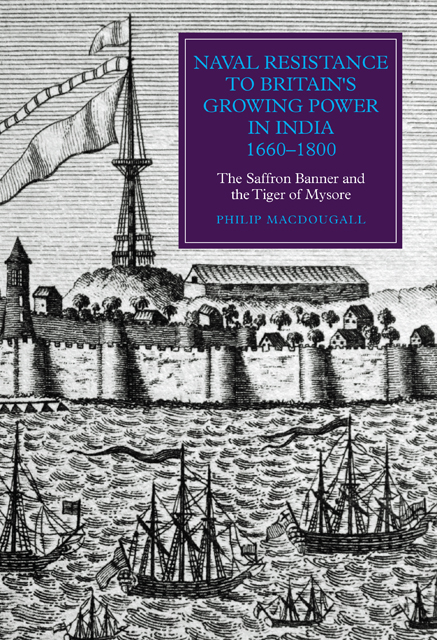 Naval Resistance to Britain's Growing Power in India, 1660–1800
Naval Resistance to Britain's Growing Power in India, 1660–1800 Book contents
- Frontmatter
- Contents
- List of Illustrations
- Abbreviations
- Chronology
- Maps
- Preface
- Part I Early Naval Resistance: The Historical Background
- Part II The Saffron Banner: Irregular Naval Warfare against an Emergent Britain
- Part III The Tiger of Mysore: A Conventional Navy to Oppose British Dominance
- Conclusion
- Bibliography
- Index
- Worlds of The East India Company
6 - Vijaydurg: The Strongest Place in All India
Published online by Cambridge University Press: 23 February 2023
- Frontmatter
- Contents
- List of Illustrations
- Abbreviations
- Chronology
- Maps
- Preface
- Part I Early Naval Resistance: The Historical Background
- Part II The Saffron Banner: Irregular Naval Warfare against an Emergent Britain
- Part III The Tiger of Mysore: A Conventional Navy to Oppose British Dominance
- Conclusion
- Bibliography
- Index
- Worlds of The East India Company
Summary
Gheria [Vijaydurg] is extremely well fortified both by Art and Nature: it lies on a Peninsula in the Lat. of 16 Deg. 40 M. North. The isthmus which joins it to the main continent is not 100 yards over, where a large trench is cut from sea to sea, and is without doubt the strongest place in all India; and only wanted a proper set of people to defend it.
Unnamed officer serving on British naval warship Tyger, 11 March 1756
Vijaydurg lies on the bank of the River Vaghotan, some 250 miles south of Bombay. Here was located the chief naval base of the Marathas, its importance marked by numerous endeavours on the part of the British to capture this facility; one particular siege marking the beginning of the war and another bringing this same war to a conclusion. Nowhere along the Konkan Coast was there a naval harbour better defended or better placed to control the movement of shipping along the west coast of India and it is for this reason that Vijaydurg is often referred to as the Gibraltar of the east.
The dominant feature of Vijaydurg is its massive fortress with walls that encompass an area of around seventeen acres and, unlike now, during the time of the Angres separated from the mainland and only approachable by way of a wooden bridge that could be drawn up. In places, the walls that enclose the fortress stretch to a height of thirty-five metres while in thickness they often exceed eight metres. Ensuring that no enemy can approach unseen or shelter safely under the walls, a total of twenty-seven bastions protrude from the walls, these once heavily armed with cannon. At the time of the final siege, when it was eventually captured by troops of the EIC and forces loyal to the Peshwa, with whom the Angres had fallen out, a total of 250 cannon were captured, these having stood upon the fortress bastions and the walls of the fort. Even today, its pock-marked walls, where cannon balls once smashed against it, provide clear evidence of the numerous conflicts witnessed by the fort at Vijaydurg, while within sling-shot balls abound.
- Type
- Chapter
- Information
- Naval Resistance to Britain's Growing Power in India, 1660–1800The Saffron Banner and the Tiger of Mysore, pp. 106 - 132Publisher: Boydell & BrewerPrint publication year: 2014


